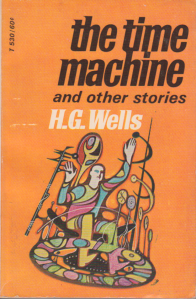The Book: The Invisible Man by H.G. Wells. Originally published in 1897. The edition read was published in 1967, copyright in 1963. , by Scholastic Book Services.

The Setting: England in Wells’ present day.
The Story: A mysterious man, swathed in bandages, moody, and demanding, arrives at a rural inn. He’s a strange fellow, and is eventually discovered to be invisible. Upon discovering this, the townspeople attempt to apprehend him (because he stole money while invisible, not just because they can’t see him). He escapes and runs rampant all over town, freaking out the townspeople. He leaves, terrorizing various people along his journey until, wounded after an altercation, he seeks refuge by breaking into a random house outside town. As chance would have it, it’s the home of Kemp, a former classmate of the Invisible Man. The Invisible Man monologues for about 50 pages, recounting how he, Griffin by name, became invisible. Apparently, it’s important to be an albino for it to work. Also, being invisible is not all it’s cracked up to be – especially in January. When you’re naked and didn’t think to make yourself an invisible jacket. Anyway, Kemp tries to get Griffin arrested, Griffin escapes, and returns the next day, trying to kill Kemp and promising a reign of terror. Kemp lives, Griffin dies, and in so doing, becomes visible once again.
The Science: The idea here is that any body, human or otherwise, can be changed to match the refractive index of light, which will make it effectively invisible. To be successful, you must be albino and drink a potion which bleaches the blood of all its color, then stand between a couple of things that vibrate in the right way, and away you go! Being an albino is important, otherwise, you end up as a pair of floating eyeballs. And no one wants that. DO NOT TRY AT HOME.
The Reaction: What an odd little book. Told partly from a sort of police report accounting, with the author breaking in and referring to himself at least once, the book is partly comedy, partly memoir, partly terror. And all quite effective. There’s no real hero of the book, not until maybe the end, and the Invisible Man is a real psychopath, increasingly unsympathetic. I do wonder how many more extended monologues I’ll encounter from Wells, though. I liked it!
The Cover: Cover design by Constance Ftera. You know, I think this is a lovely cover. It’s sort of poignant. It’s a cover which makes me want to sympathize with the Invisible Man, something which becomes impossible once he leaves the inn.
Next Up: Short story! “The Man Who Could Work Miracles” by H.G. Wells.
 The Book: The Time Machine and Other Stories by Herbert George (H.G.) Wells. The edition read was published in 1969 (copyright 1963) by Scholastic Book Services.
The Book: The Time Machine and Other Stories by Herbert George (H.G.) Wells. The edition read was published in 1969 (copyright 1963) by Scholastic Book Services.




